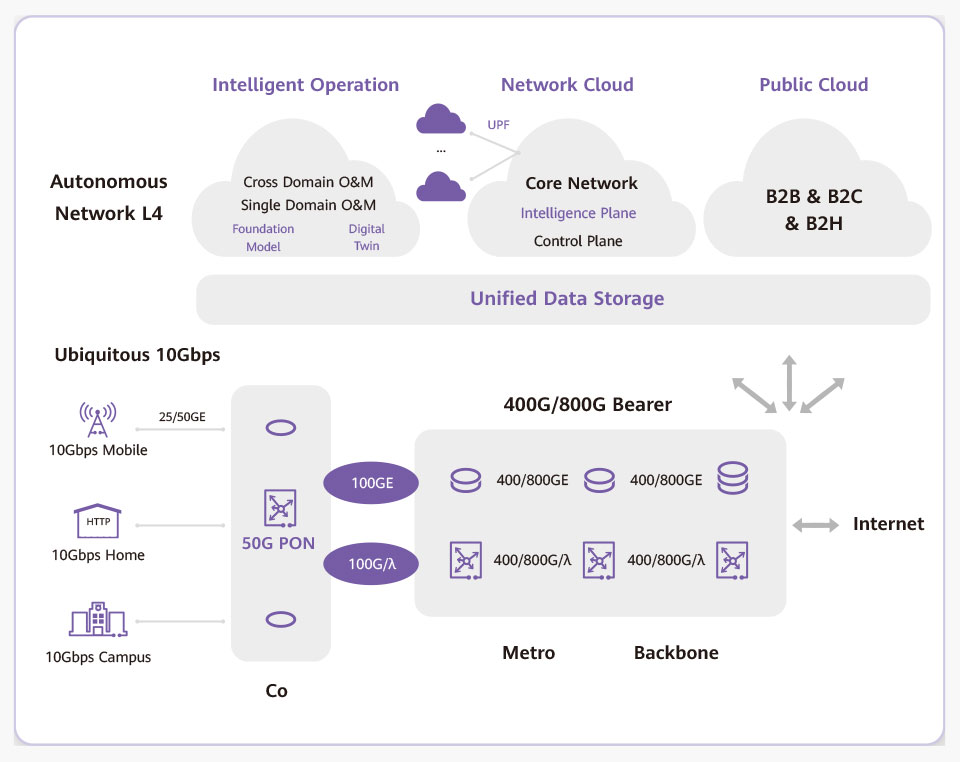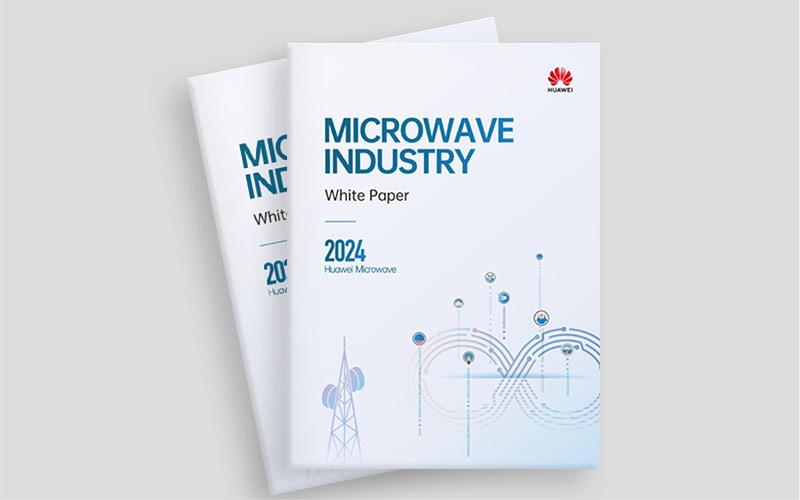Industry Trends
Jointly Defining ICT Architecture for 5.5G: The Key to Unlocking New Opportunities
For carriers to maximize the value of their infrastructure and stimulate new demand, they need to redefine ICT architecture, evolve their ICT infrastructure, embrace autonomous networks, rethink their public cloud strategy, and reassess their approach to data storage.


By Dang Wenshuan, Chief Strategy Architect, Huawei
Technologies (ICT) like 5G, cloud computing, and AI are seeing broad adoption on a global scale. In addition to revitalizing user experience, these technologies are also bringing exciting changes to the telecom industry, like new 5G business models, services, and devices, new forms of home connectivity, AI applications, and carrier-operated public cloud services. These new developments will give carriers the opportunity to maximize the value of their infrastructure and stimulate new demand.
But to get there, carriers also need to adapt: They'll have to redefine ICT architecture, evolve their ICT infrastructure, embrace autonomous networks, rethink their public cloud strategy, and reassess their approach to data storage. These efforts will put carriers in a better position to seize new opportunities and raise the entire industry to new heights.
Six megatrends in telecoms
Trend #1: New business models are paving the way for 5G growth
Driving the commercial success of 5G is top of mind in the industry. Carriers around the world have been exploring a number of different business models for 5G, and along the way have made huge headway in monetizing their network capabilities.
Some notable examples include: The Finnish carrier Elisa differentiates 5G packages based on preferred downlink speed, which has driven more users to upgrade and ultimately increased Elisa's 5G ARPU by more than €3.
China Unicom Guangdong launched special 5G livestreaming packages, which provide subscribers with greater uplink speeds, network priority levels, and data limits for a smoother livestreaming experience. By the end of 2023, these packages brought in 500,000 new subscribers, increasing the carrier's ARPU by 76% compared to regular 5G service packages.
Thai carrier AIS now provides on-demand 5G boost packages, while Three in Hong Kong offers 5G packages specially designed for stock market tracking and gaming. Both carriers charge their subscribers based on customized network priority levels, latency, and traffic volume.
China Mobile launched 5G service packages specifically for delivery couriers. In China, delivery workers go through tons of data and minutes to manage logistics and contact their customers. In addition to providing custom 5G packages with more minutes and data, China Mobile also offers road accident insurance and dedicated lounges in their service centers, where couriers can take a rest, get something to drink, and charge their phones. These diversified offerings have attracted a number of high-value subscribers.
Moving forward, new 5G business models that monetize different combinations of service capabilities will keep emerging as carriers work to better understand behavioral changes in the digital age. And by providing more targeted communications services, carriers will be able to generate more lucrative returns and set the stage for a healthy 5G business.
Trend #2: New 5G services and applications are flourishing
In 2023, we saw incredible progress in new 5G services and applications that the industry has been looking for.
China Mobile Jiangsu launched its New Calling service in September 2023 and attracted 1.5 million subscribers in only three months. Within the first six months of launching its cloud phone service, China Mobile signed up 11 million users. Globally, 5G fixed wireless access (FWA) is now serving more than 160 million users, attracted by 5G's enhanced experience and the growing affordability of 5G customer premises equipment (CPE). To date, there are now 155 carriers offering commercial FWA services around the world, double the number in 2021.
Carriers outside China are also rapidly scaling their 5G business in the B2B market. Between 2022 and 2023, 5G private networks for enterprise customers also doubled to 222, spanning industries like media, healthcare, education, ports, manufacturing, oil & gas, and mining.
New 5G services and applications are undoubtedly creating new growth momentum in the industry.
Trend #3: Novel smart devices are multiplying
Smart devices are the primary vehicle through which consumers make use of network capabilities, and they are also a major driver of industry development. A number of novel smart devices hit the market in 2023. So far, there are already five smartphones powered by 3CC carrier aggregation (CA) – a capability that's fundamental to delivering the 5.5G experience. The availability of these smartphones suggests that device vendors have outpaced network providers in the upgrade to 5.5G.
Spatial computing and AI technology are giving rise to innovative applications like glasses-free 3D, MR devices, and intelligent connected vehicles, as well as incredible new AI devices – all of which are creating new possibilities for the telecom industry.
Trend #4: Innovations in FTTH and FTTR are speeding up the arrival of F5.5G
The Fiber to the Home (FTTH) market is booming. In 2023, more than 50% of carriers around the world provided 1-Gbps connections for roughly 200 million home users. 1 Gbps has effectively become the new standard for home broadband, driven by nonstop innovation in passive optical network (PON) and optical distribution network (ODN) devices. The cost of FTTH build-out can be halved by using dual-port Building PON and transparent adhesive fiber.
We are also seeing an exponential increase in the number of homes with fiber to every room. Twenty-two carriers have launched Fiber to the Room (FTTR) services as of 2023. Now, FTTR is benefiting 12 million home users and bringing better connectivity to 300,000 small- and medium-sized businesses.
In November 2023, the European Telecommunications Standards Institute (ETSI) released the F5G Advanced Generation Definition in a well-timed move to propel F5.5G forward.
Trend #5: Foundation models are enabling intelligent network O&M
There are currently more than 300 AI applications for the telecom industry. And yet, these days, carriers deploy nearly 80% of their O&M engineers to work on things like network monitoring, troubleshooting, and complaint handling.
This is where an "AI for Telco" strategy can help, harnessing the power of AI to address unique pain points in network O&M. Role-specific AI copilots and scenario-based AI agents – built on foundation models and digital twins – can help to better equip O&M engineers and further enhance customer satisfaction.
AI for Telco applications are growing in number and coming into wider use. For example, AI copilots are helping call centers greatly increase their first call resolution (FCR) rate, a metric that represents the percentage of customer inquiries resolved in a single interaction. With the support of AI copilots, field maintenance engineers can also vastly cut the time it takes to perform fault recovery.
AI agent technology is valuable for tasks like optical path maintenance: identifying faults within one minute, locating them within three, and recovering within five. Deploying AI agents in high-value scenarios also helps decrease the number of serious customer complaints.
With foundation models built specifically for the telecom industry, carriers can streamline O&M in entirely new ways.
Trend #6: Carrier-operated public clouds are on the rise
When it comes to cloud services, over the years a vast majority of carriers have gone the cloud reseller route, while only a few have built and operated their own public cloud platforms. But the tides are turning. In Africa, for example, Ethio Telecom released its own cloud computing service platform in the third quarter of 2022. Currently, this platform offers more than 60 localized SaaS applications, exceeding the number of its globalized SaaS offerings.
As digitalization continues to sweep across the globe, localized digital services like mobile payments, online shopping, food delivery, ride hailing, and digital government are flourishing. This presents huge opportunities for carriers with local service advantages to develop public cloud services. These opportunities are unfolding in Asia-Pacific, Latin America, and the Middle East, where more than 20 carriers are launching or have plans to launch their own public clouds. The time is ripe for carriers to rethink their public cloud strategy.
Defining ICT architecture for 5.5G and evolving ICT infrastructure
To seize the new opportunities brought about by these megatrends, we need to address a number of shared challenges in the industry, including defining our overall ICT architecture, its key features, and implementation paths in the 5.5G era.
Our proposed ICT architecture for 5.5G has six defining features: ubiquitous 10-Gbps access, 400G/800G transport networks, core networks with new user planes and intelligence planes, L4 autonomous networks, carrier-operated public cloud services, and AI-oriented unified data storage. (See Figure 1.)

Figure 1: Proposed ICT architecture for 5.5G
Feature #1: Ubiquitous 10 Gbps access
"Ubiquitous 10-Gbps access" includes mobile, home, and campus scenarios.
For mobile users, extremely large antenna array (ELAA) technology and the availability of more frequency bands can help deliver a first-class experience with 10-Gbps downlink and 1-Gbps uplink.
Energy efficiency will also be a key metric of future wireless network performance. To ensure "0 Bit 0 Watt", where the lowest possible amount of energy is consumed when no bits of data are transmitted, we need to constantly push the limits of our kit. Huawei has launched a series of products to help carriers build leading 5.5G wireless networks for all scenarios, including the industry's only TDD 128T MetaAAU with a 12 Gpbs capacity, the industry's only dual-band 64T MetaAAU that supports a 5 Gbps experience, FDD tri-band Massive MIMO sites, RRUs, mmWave high-frequency AAUs, and LampSite X.
At the same time, Wi-Fi 7, FTTR C-WAN architecture, and 50G PON can be used to bring a 10 Gbps experience into people's homes. To help accelerate the adoption of 10G PON, Huawei has launched a next-generation FTTR product, the iFTTR F50 series; our brand-new MA5800T, the only OLT platform in the industry that supports GPON, 10G PON, and 50G PON on one port; and our scenario-specific AirPON solutions.
For campus users and enterprises, Wi-Fi 7 and upgraded switches will help deliver a 10 Gbps experience across the board. To support this evolution, Huawei has launched its next-generation series of AirEngine Wi-Fi 7 products and CloudEngine campus switches.
Feature #2: 400G/800G transport networks
As mobile, home, and campus networks move towards 10-Gbps connectivity, metro and backbone transport networks will need to support end-to-end 400G and smooth evolution to 800G. At the IP layer, capabilities such as E2E SRv6 and network slicing will be necessary to support multiple services at the same time. These can help carriers satisfy transport requirements for mobile and home scenarios, while seizing opportunities in the enterprise market, such as multi-cloud migration. At the optical transmission layer, applying pooling architecture to metro networks, and leveraging E2E OXC in both metro and backbone networks, will deliver ultra-low latency, ultra-large capacity, and optimal total cost of ownership. In this regard, Huawei has launched a series of routers and optical transmission products that promise an industry-leading performance and advanced functionality.
Feature # 3: Core networks with new user planes and intelligence planes
Core networks will need new user planes and intelligence planes to enable 10-Gbps access, deliver a more intelligent and personalized experience, and enable more innovative services. Huawei can help with its Intelligent UDG, a new user plane product that supports a 10-Gbps experience. To support new intelligence planes, Huawei has also introduced its Multi-modal Communication (MMC) and Intelligent Personalized Experience (IPE) solutions.
Feature #4: L4 autonomous networks
As networks grow in complexity, intelligent O&M is a must, so key technologies like telecom foundation models and digital twins will be needed to support evolution to L4 autonomous networks. Building on its Autonomous Driving Network (ADN) solution, Huawei has released a series of role-specific AI copilots and scenario-based agents, including copilots for field maintenance engineers, call centers, home broadband installation and maintenance engineers, and marketing managers, as well as AI agents for optical path maintenance, high-value scenario assurance, network risk management, and user impact event management.
Feature #5: Carrier-operated public cloud services
Finding the right partner to help seize new opportunities in the public cloud market should be a key consideration as carriers build out and operate their own cloud service platforms. Huawei supports several different partnership models to help carriers thrive in this market, such as deploying Huawei Cloud Stack on-premises, or running Cloud On Cloud using Huawei Cloud's local nodes. Building on years of experience in public cloud services, Huawei also provides joint marketing support, as well as operation and ecosystem-centric enablement to help carriers make the most of their local cloud markets. Carriers have a number of advantages in local markets, including their infrastructure, their brand, as well as business development and delivery capabilities, so they are well-poised to find a development model that helps maximize their opportunities in public cloud.
Feature #6: AI-oriented unified data storage
As AI gains traction around the world, data will become an even more important driver of productivity. This will raise new requirements for data storage. The size of AI training datasets has grown from billions of parameters to hundreds of billions of parameters, and databases need to perform millions of reads per second, rather than just tens of thousands per second. The bar is rising for bandwidth as well. To support unified data storage in the age of AI, Huawei has launched its OceanStor series of products to greatly improve AI training efficiency and GPU utilization. OceanStor can also be used in key application scenarios, such as billing and CRM, to support unified data storage.
A journey of a thousand miles begins with a single step. Huawei looks forward to working with all industry players to identify key trends and changes in the industry, jointly define ICT architecture for 5.5G, and drive the evolution of ICT infrastructure. Together, we can achieve shared success and raise the telecom industry to new heights.
- Tags:
- 5.5G






